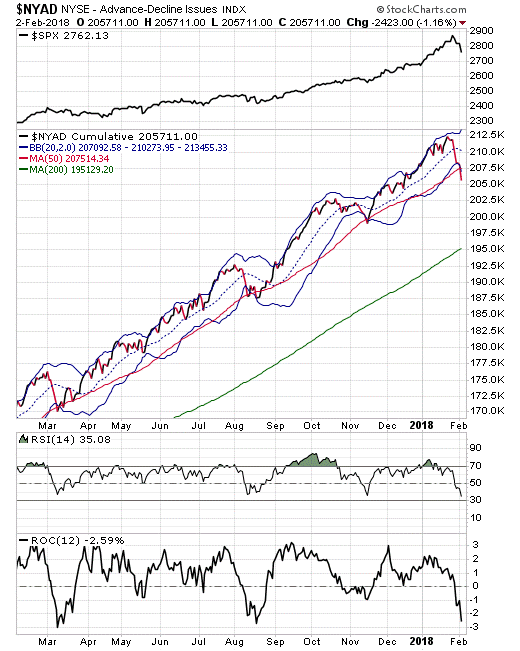SPXIf nothing has changed, this will be yet another opportunity to buy the proverbial dip and ride the wave. The question is whether the rules in place for the last 18 months still apply. We should know soon, asserts Joe Duarte, MD of Joe Duarte In The Money Options.
Janet Yellen should take a walk from her lofty new Brookings Institution office, head down to the corner 7-Eleven, and buy a lotto ticket while Jerome Powell should stock up on Tylenol and Valium. That’s because she’s gone from the Fed and he’s inheriting a nasty little mess.
All kidding aside, we may be in the early stages of a bear market or we may be close to yet another buy-the-dip and race to new highs moment in the stock market.
Indeed, only the robots know what lies ahead. Strangely enough, my all too human gut is telling me that this may not be the final top for this bull market. Honestly, I just don’t have the heartburn I would normally get during a bear market, of which I’ve seen and felt too many.
At least not yet. Sure, I may be wrong – the Tums bottle is nearby - and I don’t want to be cynical, but it seems as if a bear market would be highly inconvenient to just about everyone at the moment, especially the Fed’s new president, Jerome Powell. Does he really want to start his tenure being seen as a guy who can’t straighten out a market selloff?
Moreover, even if the Fed gets caught behind the eight-ball (as usual), during the last eighteen months robotic trading algorithms have pushed stock prices ever higher. Prices are fueled behind simple trend following technical analysis techniques and mechanical reaction to headlines favorable to the Trump side of the ledger.
Of course, that may have changed. On February 2, as the Federal Reserve turned up the hawkish comments and the political uncertainty rose to a fever pitch after the release of the so called FISA memo, a seeming Trump win, the market sold off and it seems as if the robots are confused.
A new Trump trade?
The Trump trade, since mid-2016 was pretty simple; a Trump win meant lower taxes, relatively low interest rates and fewer regulations. This combination of influences was seen as one which would juice the economy and thus the stock market would follow. As a result, headlines which fit the script were reasons to buy stocks, no matter what the valuation or any other external parameter would warrant.
And as the month of January proved, once the tax cuts passed, the sky was the limit.
What could possibly go wrong? How about a Congress that is perhaps dysfunctional beyond repair due to the political situation, and thus may not be able to pass the next Trump plan? I’m, of course, describing a scenario in which the Democrats and the Republicans are so embroiled in the politics of the moment that even the majority party – the GOP – can’t muster enough votes to pass the proposed $1.5 trillion Trump infrastructure plan, which according to the algos reaction on Friday may now be something that has died after the FISA memo.
Of course, no one really knows what’s next, or what’s in the electronic mind of the algos and their programmers.
What we do know is that volatility is back, as is the likelihood of higher interest rates from the Fed and the bond market.
Yet for investors there is only one fundamental question – what will the robots do? If the algo programmers stick to their usual tendencies, the market will follow the simple script of the past 18 months, based on bare bones technical analysis and skin depth only analysis of headlines.
But if there is a new script, anything is possible.
Selloff is huge test for most reliable indicator of bull market
I’ve been saying it for the past 18 months: the NYSE Advance Decline line (NYAD) has been the most reliable indicator of this bull market since the summer of 2016. Indeed, this indicator, as the chart below shows, gave us a minor warning sign recently which in hindsight may prove its value, especially if this is the start of a bear market.
A close look at the chart below shows that the S&P 500 (SPX), the upper panel, made a new high on the week of January 21, while the NYAD did not.
Arguably, given the subtlety of this occurrence, I may be splitting hairs here, although I did note the following in my January 24, edition of this column that “NYAD remained above its 20-day moving average despite rolling over slightly. This rolling over, for now, remains a short-term move.”

In the same column I also noted: “If the market gets spooked, I would expect a move in NYAD down to the lower Bollinger Band (BB- lower dark blue line surrounding NYAD). If the long-term trend remains intact, a move to the lower BB would likely precede yet another rebound, similar to what we saw in March, May, August and November 2017.”
So where does that leave us? For one thing the market did get spooked. And for another NYAD is not just at its lower Bollinger Band (green lower line around NYAD), but it is outside the band, below its 20-day moving average and below the 50-day moving average (red line). Furthermore, the RSI and ROC are both at oversold levels.
Putting this all together, only one thing is clear at this point: the market, as measured by the highly reliable NYAD is now extremely oversold in the short term. Usually over the last 18 months, especially after a 500-plus down day in the Dow Industrial Average (DJI) as we had on February 2, this would mean that some type of rebound in prices should appear within the next 2-5 trading days.
It’s in the robot’s hands now
Conventional wisdom (gulp) suggests that the last thing the global central banks want at this point in the cycle is a lasting bear market.
This is especially prescient since the Swiss Central Bank and the Bank of Japan have billions of dollars invested in stocks and ETFs at the moment. By the same token, it seems reasonable to consider the last thing the robots want at this point is a low volume grinding bear market without individual and institutional investors participating. In such a market it would be very difficult to take people’s money with their spoofing and clever microsecond computer trades.
Furthermore, under normal circumstances, the market is so blatantly oversold that the simple minded technically driven programmed algorithms should be very aggressive buyers of stocks, perhaps as early as Monday.
So, if nothing has changed, this will be yet another opportunity to buy the proverbial dip and ride the wave toward new highs. The real question is whether the rules that have been in place for the last 18 months still apply. I suspect we should know within the next few days.
Joe Duarte is author of Trading Options for Dummies, now in its third edition. He writes about options and stocks at www.joeduarteinthemoneyoptions.com.






















